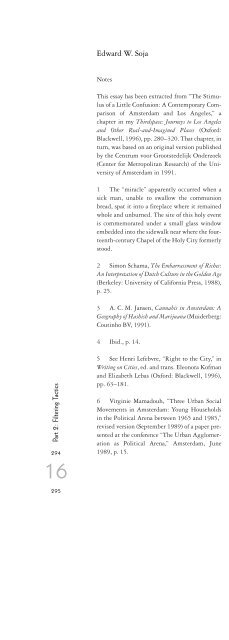The Unknown City: Contesting Architecture and Social Space
The Unknown City: Contesting Architecture and Social Space The Unknown City: Contesting Architecture and Social Space
Part 2: Filtering Tactics 294 16 295 Edward W. Soja Notes This essay has been extracted from “The Stimulus of a Little Confusion: A Contemporary Comparison of Amsterdam and Los Angeles,” a chapter in my Thirdspace: Journeys to Los Angeles and Other Real-and-Imagined Places (Oxford: Blackwell, 1996), pp. 280–320. That chapter, in turn, was based on an original version published by the Centrum voor Grootstedelijk Onderzoek (Center for Metropolitan Research) of the University of Amsterdam in 1991. 1 The “miracle” apparently occurred when a sick man, unable to swallow the communion bread, spat it into a fireplace where it remained whole and unburned. The site of this holy event is commemorated under a small glass window embedded into the sidewalk near where the fourteenth-century Chapel of the Holy City formerly stood. 2 Simon Schama, The Embarrassment of Riches: An Interpretation of Dutch Culture in the Golden Age (Berkeley: University of California Press, 1988), p. 25. 3 A. C. M. Jansen, Cannabis in Amsterdam: A Geography of Hashish and Marijuana (Muiderberg: Coutinho BV, 1991). 4 Ibid., p. 14. 5 See Henri Lefebvre, “Right to the City,” in Writing on Cities, ed. and trans. Eleonora Kofman and Elizabeth Lebas (Oxford: Blackwell, 1996), pp. 63–181. 6 Virginie Mamadouh, “Three Urban Social Movements in Amsterdam: Young Households in the Political Arena between 1965 and 1985,” revised version (September 1989) of a paper presented at the conference “The Urban Agglomeration as Political Arena,” Amsterdam, June 1989, p. 15.
- Page 594: The Un(known) City . . . function,
- Page 598: The Un(known) City . . . find that
- Page 602: 15.2 | Vauxhall Cross: longitudinal
- Page 606: The Un(known) City . . . they are b
- Page 610: Notes 1 “Behind Closed Doors” w
- Page 614: This page intentionally left blank
- Page 618: In Amsterdam in 1990, I dwelled for
- Page 622: The Contested Streetscape in Amster
- Page 626: 16.2 | Spuistraat, Amsterdam, 1995.
- Page 630: The Contested Streetscape in Amster
- Page 634: The Contested Streetscape in Amster
- Page 638: The Contested Streetscape in Amster
- Page 642: The Contested Streetscape in Amster
- Page 648: Lynne Walker 17 Home and Away: The
- Page 652: Part II: Filtering Tactics 298 17 2
- Page 656: Part II: Filtering Tactics 300 17 3
- Page 660: Part II: Filtering Tactics 302 17 3
- Page 664: Part II: Filtering Tactics 304 17 3
- Page 668: Part II: Filtering Tactics 306 17 3
- Page 672: Part 2: Filtering Tactics 308 17 30
- Page 676: Part 2: Filtering Tactics 310 17 31
- Page 680: Part III Tactics
- Page 684: Nigel Coates 18 Brief Encounters a
- Page 688: Part III: Tactics 316 18 317 Nigel
- Page 692: Part III: Tactics 318 18 319 Nigel
Part 2: Filtering Tactics<br />
294<br />
16<br />
295<br />
Edward W. Soja<br />
Notes<br />
This essay has been extracted from “<strong>The</strong> Stimulus<br />
of a Little Confusion: A Contemporary Comparison<br />
of Amsterdam <strong>and</strong> Los Angeles,” a<br />
chapter in my Thirdspace: Journeys to Los Angeles<br />
<strong>and</strong> Other Real-<strong>and</strong>-Imagined Places (Oxford:<br />
Blackwell, 1996), pp. 280–320. That chapter, in<br />
turn, was based on an original version published<br />
by the Centrum voor Grootstedelijk Onderzoek<br />
(Center for Metropolitan Research) of the University<br />
of Amsterdam in 1991.<br />
1 <strong>The</strong> “miracle” apparently occurred when a<br />
sick man, unable to swallow the communion<br />
bread, spat it into a fireplace where it remained<br />
whole <strong>and</strong> unburned. <strong>The</strong> site of this holy event<br />
is commemorated under a small glass window<br />
embedded into the sidewalk near where the fourteenth-century<br />
Chapel of the Holy <strong>City</strong> formerly<br />
stood.<br />
2 Simon Schama, <strong>The</strong> Embarrassment of Riches:<br />
An Interpretation of Dutch Culture in the Golden Age<br />
(Berkeley: University of California Press, 1988),<br />
p. 25.<br />
3 A. C. M. Jansen, Cannabis in Amsterdam: A<br />
Geography of Hashish <strong>and</strong> Marijuana (Muiderberg:<br />
Coutinho BV, 1991).<br />
4 Ibid., p. 14.<br />
5 See Henri Lefebvre, “Right to the <strong>City</strong>,” in<br />
Writing on Cities, ed. <strong>and</strong> trans. Eleonora Kofman<br />
<strong>and</strong> Elizabeth Lebas (Oxford: Blackwell, 1996),<br />
pp. 63–181.<br />
6 Virginie Mamadouh, “Three Urban <strong>Social</strong><br />
Movements in Amsterdam: Young Households<br />
in the Political Arena between 1965 <strong>and</strong> 1985,”<br />
revised version (September 1989) of a paper presented<br />
at the conference “<strong>The</strong> Urban Agglomeration<br />
as Political Arena,” Amsterdam, June<br />
1989, p. 15.



